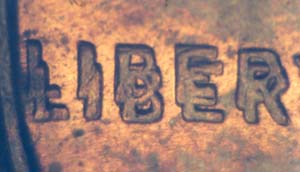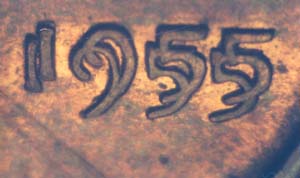
Doubled Dies:
Class I: Rotated Hub Doubling
Rotated Hub Doubling
This coin exhibits hub doubling that occurred as a result of a rotation of the hub or die at a point near the center of the design. This rotation can be either clockwise or counterclockwise and affects all design elements, the strongest doubling being around the rim. The most famous doubled die of all, and the one which made variety collecting a force to be reckoned with in the numismatic community, is the 1955 hub doubled Lincoln cent. Its doubling is attributed to a rotated hub. The examples I have chosen have a large spread between the images. Don't let that fool you. Rotated doubled dies can have very small spreads. The point to notice is that the doubling is all the way around the rim elements. It may be stronger in one area and weaker in another (caused when the point of rotation is not the exact center), but there will be doubling all the way around. If there is a spot where there is no doubling then look for a Class V: Pivoted hub.
LIB of LIBERTY Date Notice how the doubling flows down through LIBERTY and up through the date.
| Home |
Introduction |
Design Changes |
Mintmark Styles |
Doubled Dies |
Mintmark Varieties |
RPDs and MPDs |
Die Errors |
| About CONECA |
About the Author |
Copyright James Wiles, 2011
Email: jameswiles@sbcglobal.net
1490 Trail View Lane
Frisco, TX 75034-2649

